26 Tuesday Jan 2021
Posted in Uncategorized
26 Tuesday Jan 2021
Posted in Uncategorized
04 Monday Feb 2019
Tags
1930s quilts, Cathedral Window Quilts, Handmade, quilt collections, quilt study, vintage fabrics, vintage quilts

I had been searching for a vintage Cathedral Window quilt for a very long time and I was surprised and delighted to have found this beautiful one on Ebay. I waited with much anticipation for the quilts arrival. On opening the box I could not believe how beautiful the quilt was. It appears to have never been washed or used.


The maker of this quilt was certainly a skilled needlewoman. The quilt is constructed of 323 full ‘windows’ and 72 ‘half windows’ which are stitched in a solid pink. These create a border around the outside edges.
The quilt contains a wonderful array of 1930s dressmaking fabrics and probably some feedsacks.
The Cathedral Window pattern is a difficult and time consuming design. The maker of this quilt also added some hand quilting during the construction method. This is not commonly found on Cathedral Window Quilts but it creates a lovely effect.

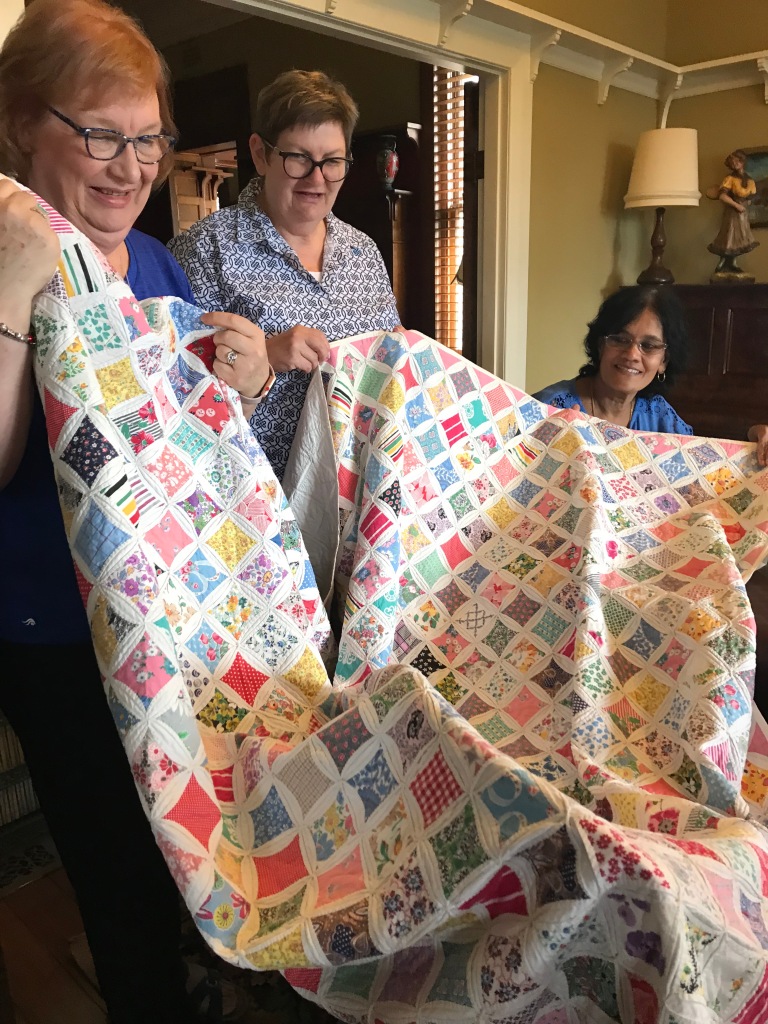
Unfortunately there was no provenance or information to be handed on with this quilt. However, it is in safe keeping and being admired for it’s amazing array of fabrics, the skillful stitching and the many hours spent in it’s making. It truly was a labour of love.
Thank you for your interest. Happy stitching, regards Janette – The Plain Needlewoman
02 Friday Nov 2018
Posted in Uncategorized

I made this quilt in memory of my mother Marjory Myers (nee Wilson). My mother was known as Marjie by all who knew her. Her Grandchildren called her Nanna Marj and other young friends called her Auntie Marj. My Mum loved to go Op Shopping (as I do too). She found many treasures for her friends and family and loved to find a bargain. Both my Grandmothers were seamstresses, Mum and her sisters all sewed and a brother was a tailor. Most of my clothes were made by Mum, usually from remnants, sale pieces and sometimes re-made from other items of clothing.
I started sewing, knitting and embroidery at a very young age as we were encouraged to make use of any spare time. In the 1970s I started making quilts from dressmaking scraps and purchased cotton fabric if available. I continued to teach myself machine and hand piecing, and hand quilting. These were busy days as we were running a newsagents and raising three children. Being a newsagent meant I add access to the quiltmaking magazines coming in from America and I found these very inspiring and informative. Mum was interested to see what I was making and started keeping a look out for fabric at op shops. It was a lovely surprise when Mum would pop in with some old pieces she had found on her shopping expeditions.


When I saw this pattern in Quiltmaker Magazine January/February 2000 called Star Chain, I knew it would be the perfect pattern to make in memory of my Mum. I used many fabrics that Mum had found for me including the pink solids and lots of scraps. The quilt is hand pieced and hand quilted.
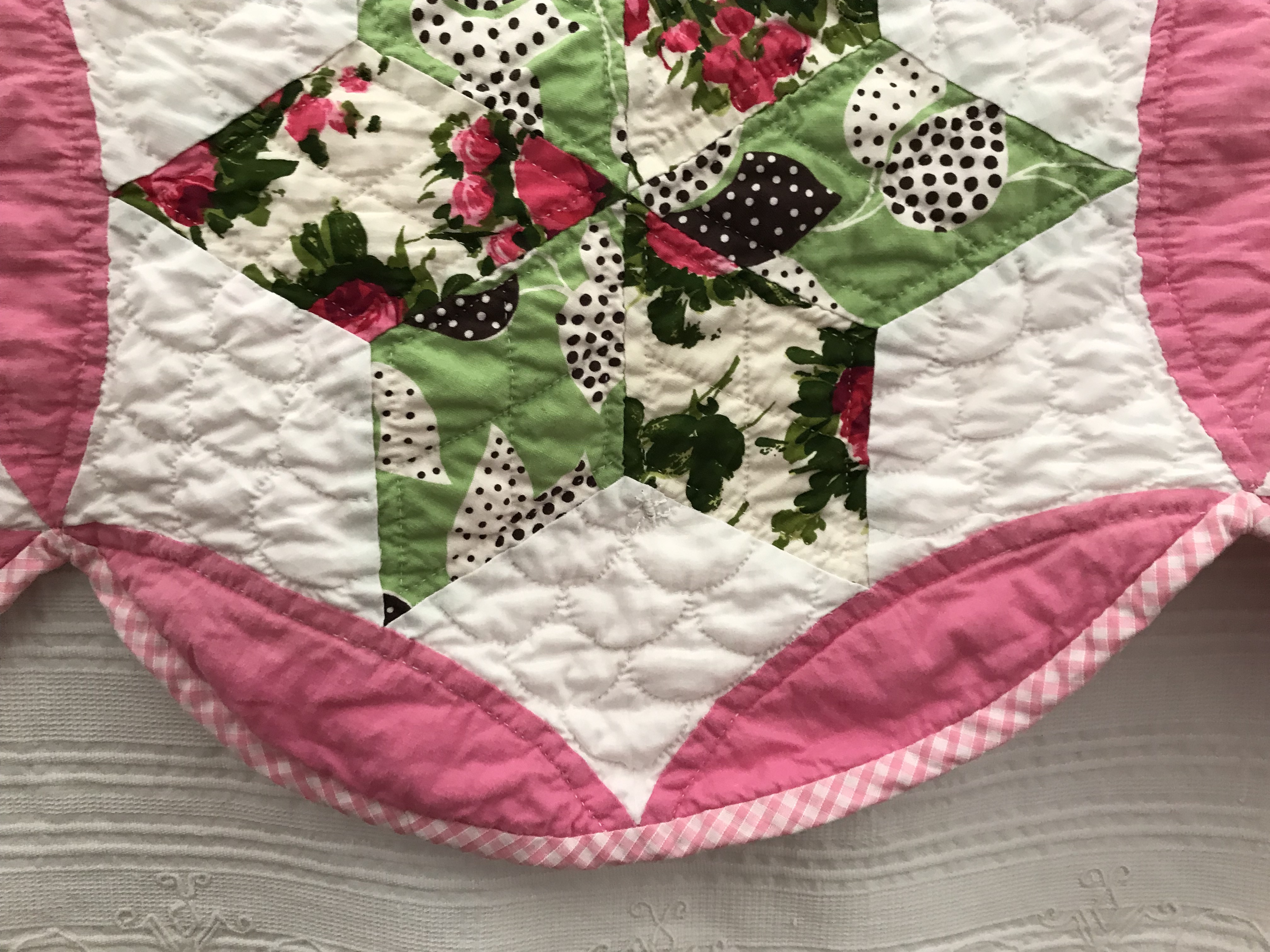

This is the third quilt in a series I have been working on for a number of years. I have made one for my mother-in-law, called Alice’s Tulips, one for my paternal grandmother, called English Ivy and have recently completed hand piecing a quilt in memory of my maternal grandmother called May’s Star. I wanted to honour these strong women who were all so influential and important to me. Happy Stitching and thank you.
20 Friday Jul 2018
Tags
collections, Coverlets, embroidery, Handmade, handwork, Hard times, old quilts, original designs, Quilting, quilts, vintage fabrics, vintage quilts
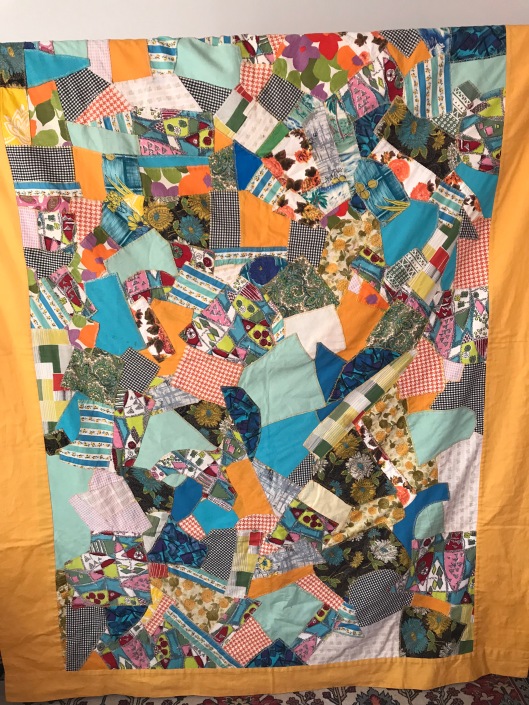 There is no provenance on this crazy style patchwork coverlet, but it was found in Melbourne. The fabrics suggest it was made in the post war era, probably 1950s. This style of quilt making is documented in Margaret Rolfe’s books on the traditions and history of Australian quilt making.
There is no provenance on this crazy style patchwork coverlet, but it was found in Melbourne. The fabrics suggest it was made in the post war era, probably 1950s. This style of quilt making is documented in Margaret Rolfe’s books on the traditions and history of Australian quilt making.
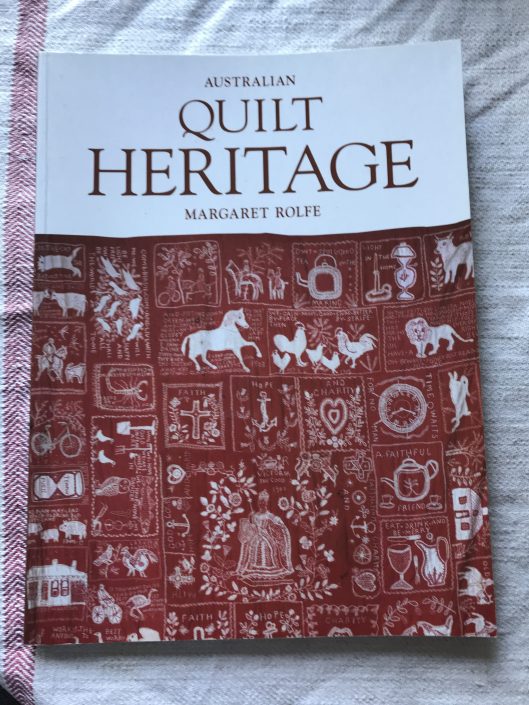
The coverlet contains a time capsule of dressmaking and home furnishing fabrics from an era when most women stitched clothing for themselves and their families. The fabrics used include ginghams, barkcloth, stripes, checks, double knits, woven houndstooth and many bright floral and geometric designs. The border is a sunny yellow Cesarine. Cesarine was used extensively in the 1950s and 1960s.
The maker of this quilt carefully turned under the raw edges of her patches and hand tacked narrow hems before overlapping the irregular pieces which she stitched directly onto the one piece of calico backing.
Working on such a large piece must have been difficult at times. The coverlet measures 170 cm x 202 cm
The seams are finished with featherstitching. The border was stitched by machine to the right side of the coverlet, neatly folded over and hand sewn to cover the raw edge at the back.

Small opening shows the construction method used
It is interesting to study the back of the coverlet which is as neat as the front.
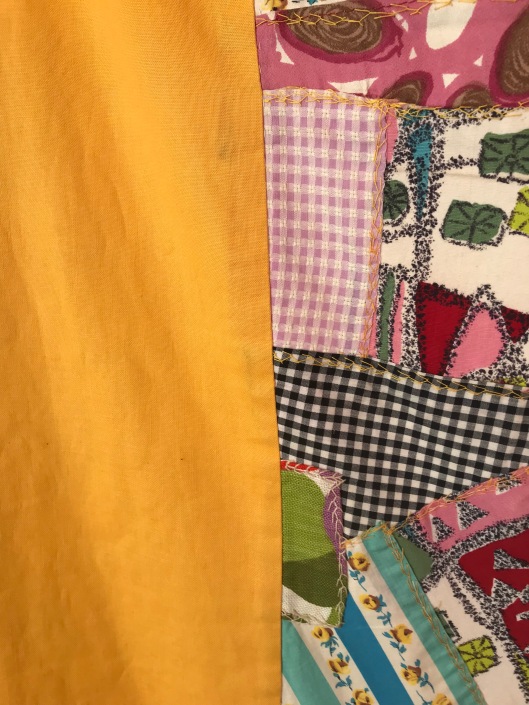
Front border detail

Detail of fabrics

Gingham, florals and geometrics
The quilt appears to have never been used or washed.
I am very happy to have another wonderful example of an Australian quilt in my collection. It is much valued. I am glad this quilt maker saved her sewing scraps and made this quilt. It provides a great opportunity to study the fabrics and designs of this era. Happy stiching, Janette – The Plain Needlewoman
23 Saturday Jun 2018
Tags
Antique Quilts, collections, Coverlets, Handmade, handwork, hexagons, old quilts, original designs, Paper Piecing, Quilting, quilts
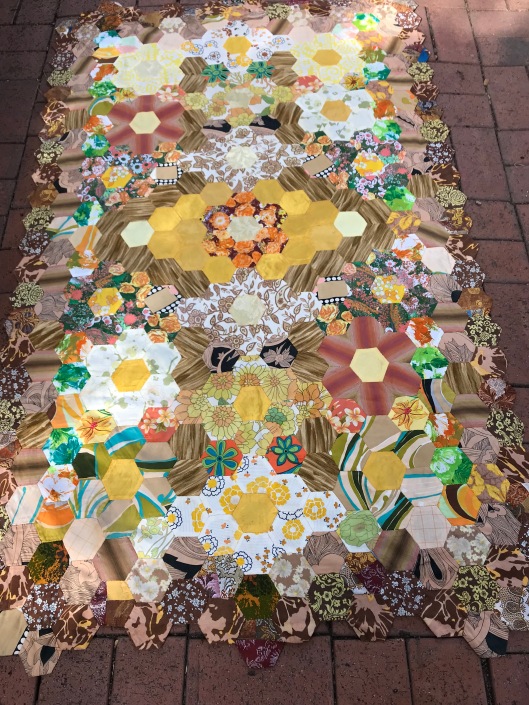
This coverlet from Clarence Valley, New South Wales may possibly have been made by the needlewoman who made the coverlet that I documented in the previous post. I purchased this from the same Ebay seller who had bought both of them. Unfortunately, no other information is known. But what we do know is that the coverlet was designed and stitched by an experienced seamstress who had a good array of fabric scraps available to her. Most likely the fabrics were saved from dressmaking.
The coverlet is double sided.

Reverse side of coverlet
The coverlet measures 178 x 105 cms. The hexagons measure 7 cm through the centre and 4 cm on the outside edge. The fabrics used in the coverlet include cotton, silk, furnishing fabric, taffeta, sateen and figured satin. The cotton fabrics include many textured weaves and floral prints. One print in particular resembles a Liberty design. The background fabric used on the reverse side may be a wool/rayon mix. It is a heavier weight fabric with a sheen to it.
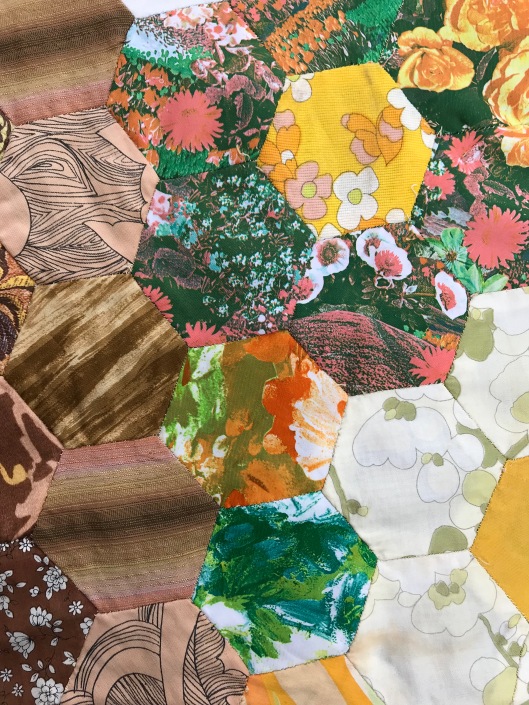
Fabric detail – side 1

Fabric detail – side 2
The quilt maker had a flair for colour and design. The colours are very typical of mid 20th century styles and decorating colours. The golds, greens, yellows and browns are artistically used throughout to define the lay-out of the designs on both sides of the coverlet. Side one is pieced with hexagons stitched to form diamond and rosette shapes. The second side uses hexagons stitched to form a large rosette which is stitched to the centre of the brown stripe background fabric. Side one includes the use of brown toned prints to create a border and side 2 makes use of green and orange prints to create the border. The edges of the quilt are neatly whip stitched together to finish the coverlet. There is no batting. The coverlet appears to have never been washed or used.

Detail of side 2.
Without further information I can only speculate about the maker of these two exquisite Australian coverlets. They are much treasured by me and I feel very lucky to have them in my collection. Australian quilts are rare and the two Clarence Valley Coverlets demonstrate fine needlework skills and a great flair for design and style. I wish there was more to tell you about the coverlets but sadly their story has been lost.
Thank you for stopping by, Janette, The Plain Needlewoman
25 Friday May 2018
Tags
Australian Quilts, collections, Fabric Study, hand piecing, hexagons, old quilts, original designs, Piecework, scrap quilts

The maker of this coverlet clearly had a vision of her finished design. The hexagons which measure 2 cm on the outside edge were cut with a 2 cm seam allowance. The seams were neatly stitched into place so there was no wrong side of fabric showing.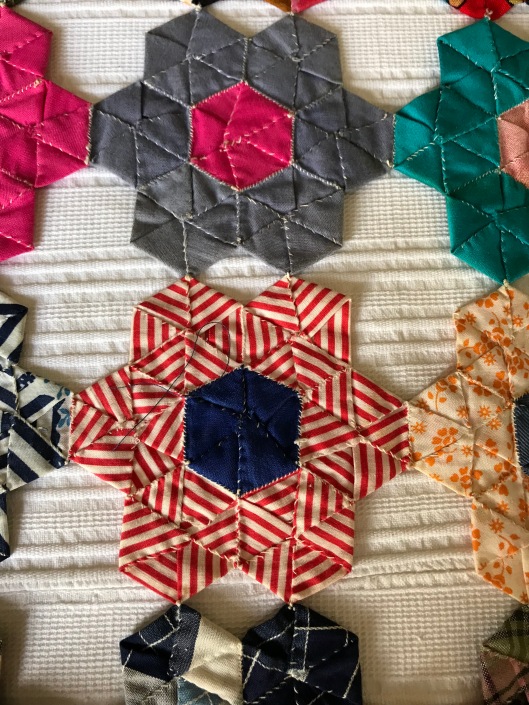
The rosettes consist of 6 hexagons stitched around a solid colour hexagon.The hexagons measure 2 cm on the outside edge. The rosettes measure 10.5 cm. The maker stitched 340 rosettes and set them together in rows of 20 x 17. Two rows – row No. 7 and 14 consist of hexagons stitched in solid colours. These two rows add definition to the design of this lovely scrappy and colourful quilt. The rosettes are joined together with a whip stitch similar to the construction of a yo-yo coverlet. The finished coverlet measures 178 cm x 198 cm.
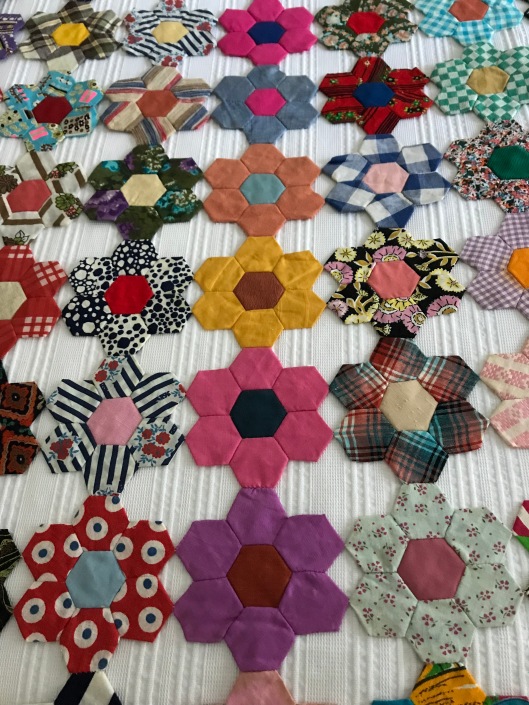
The coverlet appears to have never been used. It is beautifully constructed and a work or art. It is one of my absolute favourites and a cherished example of an Australian quilt. I purchased another coverlet from the same seller which I will write about in my next post. I can only speculate on the maker of this quilt but one thing that stands out to me is her great collection of scraps and her fine needlework skills.
Happy stitching, Janette The Plain Needlewoman
11 Wednesday Apr 2018
Posted in Australian Quilts, Feed Sack, Mending, old fabrics, Quilt Collections, stitching, vintage quilts, Waggas
Tags
1930s quilts, Australian Quilts, Bush Quilts, Depression era, Fabric Study, Hard times, old quilts, quilt collections, Wagga Quilts, Waggas, Woollen
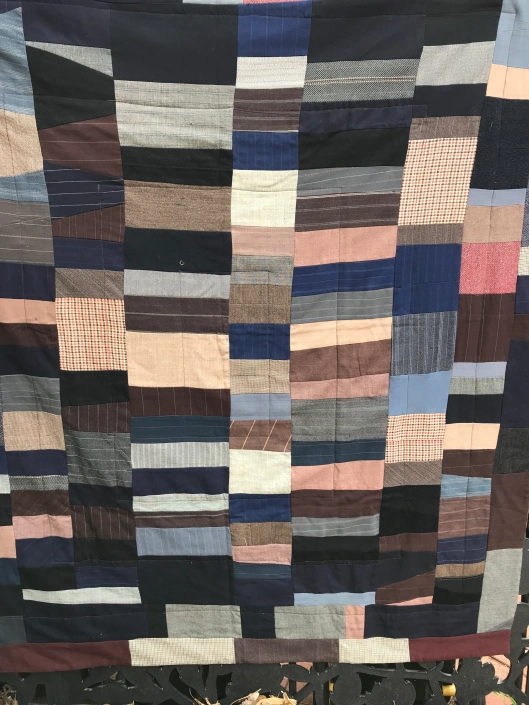
Wagga quilts are an Australian style of quilt born out of hard times and limited resources.
Originally waggas or bush quilts were a hessian sack or chaff bag filled with anything that would provide warmth. They may have been covered with an outer cotton fabric.
During the Depression Era waggas pieced from woollen tailor’s samples, remains of worn out clothing and dressmaking scraps emerged. The woollen fabrics provided much needed warmth during a period when houses were unheated. My mother recalled her mother making heavy, woollen quilts from tailor’s samples. These were used by her brothers who slept on the back verandah. They were a large family and very poor. I’m sure they appreciated their waggas.
I purchased my Wagga on eBay. It was found at a church sale in Charleston, Lake Macquarie, New South Wales. It is in very good condition. I think it may have been placed in a cupboard and forgotten until the church had a big clean up. It appears never to have been used.

Reverse of Wagga
The quilt is double sided and has an inner layer. It is very heavy. The quilt is in very good condition. There is some machine stitching used to hold the three layers together. There is no binding, indicating the quilt was layered wrong sides together, stitched and turned.
There is a great variety of woollen fabric scraps used in the quilt: including tweeds, suitings, khaki army uniform, herringbone, plaids, stripes and checks.
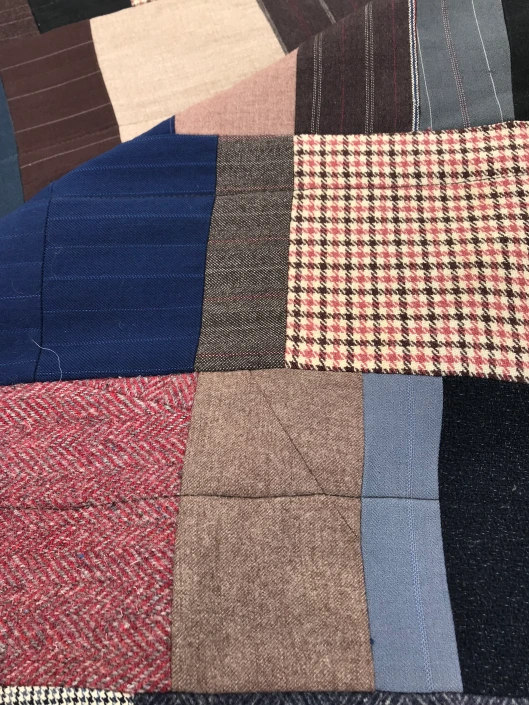
Detail of fabrics
A few little moth holes, stitched down pockets and darning all add interest to this unique Wagga. It measures 165 cm x 150 cm.

Detail of a stitched eyelet
I admire the makers flair and technique in putting together all these pieces.
Australian quilts are rare and wonderful and I love having this one in my collection.
Thank you for visiting my blog. Happy Stitching – The Plain Needlewoman Janette
09 Saturday Sep 2017
Tags
Fabric Study, hand piecing, hand quilting, handquilting, quilt collections, Quilting, reproduction fabrics, Rug Hooking, scrap quilts
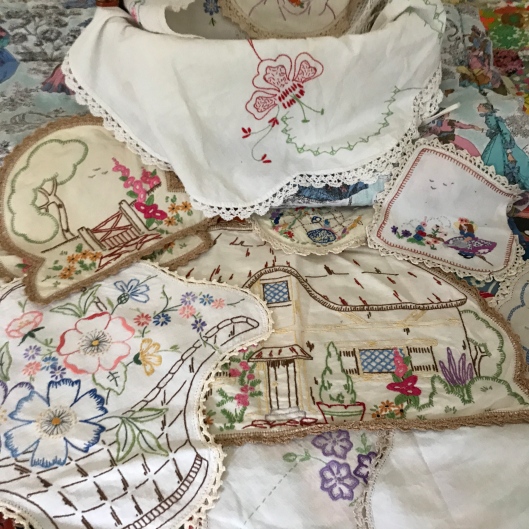
My d’oyley collection includes many embroidered pieces worked by my Mother, Aunties and a Great Aunt.

Auntie Joan’s old d’oyley
This old d’oyley embroidered by Auntie Joan became the inspiration for my latest hooked rug design ‘New Beginnings’.

New Beginnings
I hooked the rug in hand cut woollen fabrics purchased at Op Shops.
The long, cold nights during Winter provided more time for hand quilting. I completed my Peony Rose quilt and added Prairie Points for a fancy finish.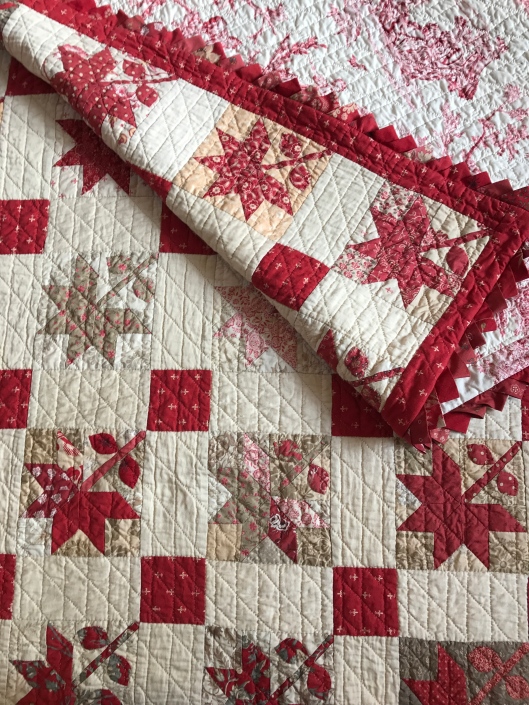


Prairie Points pressed ready to stitch together
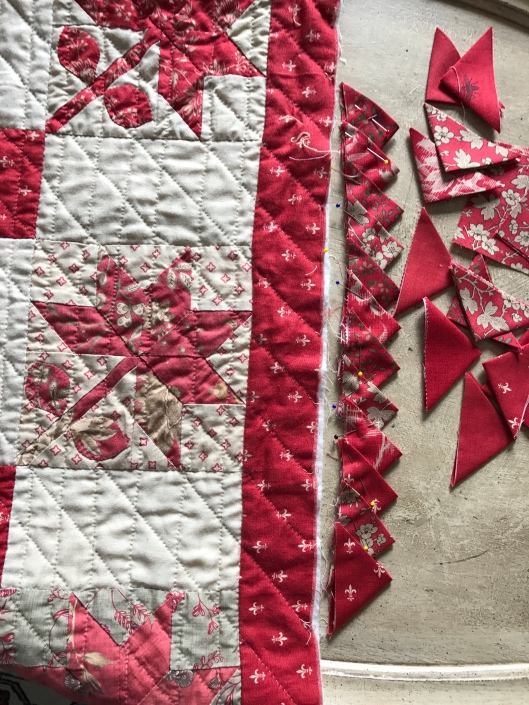
Prairie Points in place ready to add to quilt
The pattern for this quilt is from the book In The Beginning by Sharon Yenter Evans. I made Ferol’s Peony Rose in French General fabrics and used a vintage sateen for the lattice.
I have stitched two more quilt tops which are now ready for basting and hand quilting. I hand pieced the Old Fashioned Spools top and machine pieced the medallion quilt.
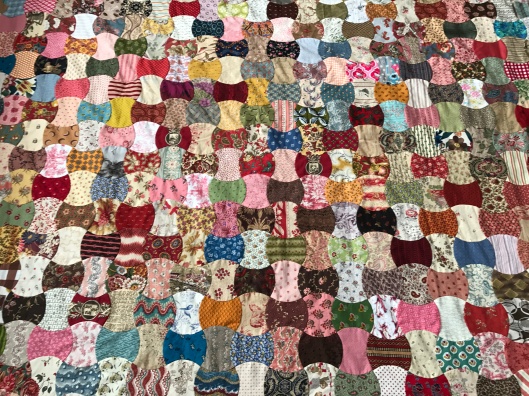
Old Fashioned Spools
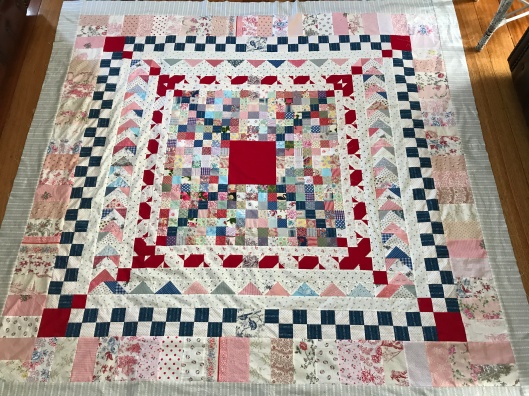
Medallion Quilt
Spring has arrived here with an abundance of golden wattle and thankfully some much needed rain.
Happy Stitching and take care, Janette The Plain Needlewoman
05 Monday Jun 2017
Tags
Coverlets, French fabrics, Handmade, handwork, hexagons, Paper Piecing, repairing and restoration, vintage fabrics

Soft, muted colours were used to create this hexagon and diamond coverlet.
The maker had a large collection of the patterned and plain material available to work with. The fabric is a heavy weight cotton, possibly furnishing fabrics.
The maker arranged the plains and patterned fabrics to create a medallion setting and fussy cut her pieces. The colours in the coverlet are subtle and beautiful. The quilt is finished with a French braid. The use of the braid to finish the edges of a hexagon quilt is worth noting.
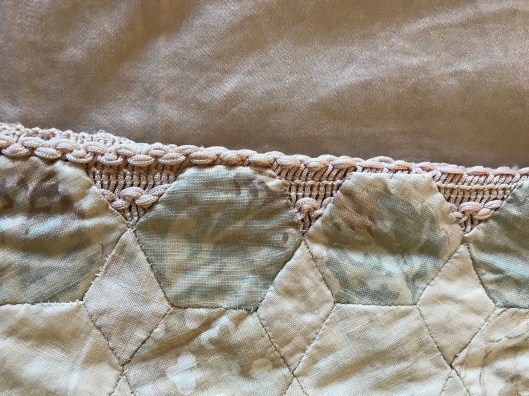
The quilt was pieced using the English paper piecing method. I found small traces of papers in the corners of the quilt, which unfortunately were too small to provide any information.

Detail of fabrics

Fussy Cutting
The quilt was purchased at an auction in country Victoria and it was stated that it was bought in France. The fabrics verify this. My research on the fabrics used in the coverlet suggest it may have been stitched between 1920s to 1950s. This is also the opinion of two textiles specialists that I consulted.
The hexagons measure 3.5 x 4 cm with an outside edge of 2 cm. The diamonds are a tiny 2 cm x 3.5 cm. The coverlet measures 220 cm x 150 cm.
There are some unravelled seams that need attention and are on my list of repairs to be carried out. Winter has arrived in my part of the world and it is perfect weather for stitching. I hope to finish quite a few quilting projects during the cooler months including repairs to some of the old quilts in my collection.

Centre of the coverlet.
Take care and Happy Stitching, Janette – The Plain Needlewoman
10 Monday Apr 2017
Tags
1890s to 1910s. Antique Quilts, Fabric Study, hand quilting, One Patch Quilts, quilt collections, reproduction fabrics, vintage fabrics

Diamond Quilt
One patch quilts have been a mainstay of quilters since people picked up needles, thread and scraps of fabric.
Squares, triangles and diamonds or more complex shapes such as hexagons and clamshells have been used time and time again to create sophisticated designs.
One patch quilts can follow a formal layout of scraps and colours or can be randomly pieced out of the scrap basket.
Either way they make wonderful quilts.
Some of the one patch quilts in my collection include squares, triangles, tumblers, hexagons and apple core shapes.

Diamonds circa 1960s.
I purchased this quilt top at an antique market and hand quilted it in the Baptist Fan design. The maker had some great fabrics in her scrap basket including one with the American State flags and the year the states joined the United States of America. The last two to join were Alaska in 1958 and Hawaii in 1959. So we can presume this fabric was purchased in 1959 or later. 
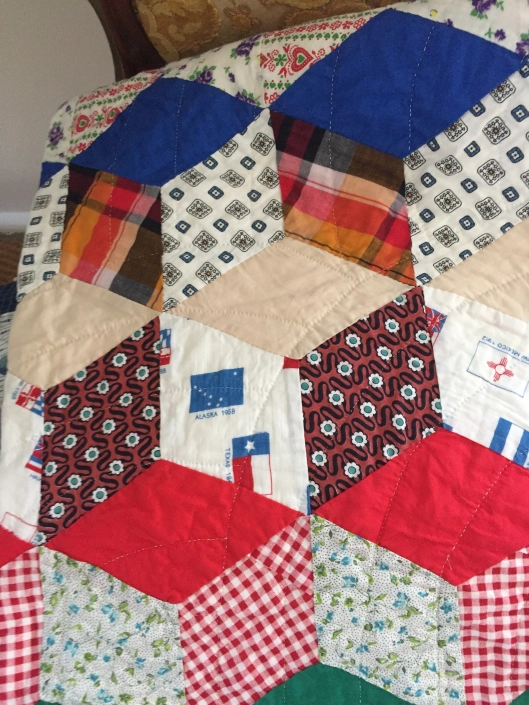
The quilter used great skill in her fabric placement. Solid colours are used for the diamonds in one direction and patterned fabrics in the other direction.

Detail of quilt and vintage fabrics used for the backing.
Old Fashioned Spools

Work in Progress
This is a quilt that I am presently hand piecing. I prefer the name Old Fashioned Spools but it is more commonly called Apple Core or Double-Bitted Axe. I am alternating light and dark fabrics throughout.
Vintage Tumbler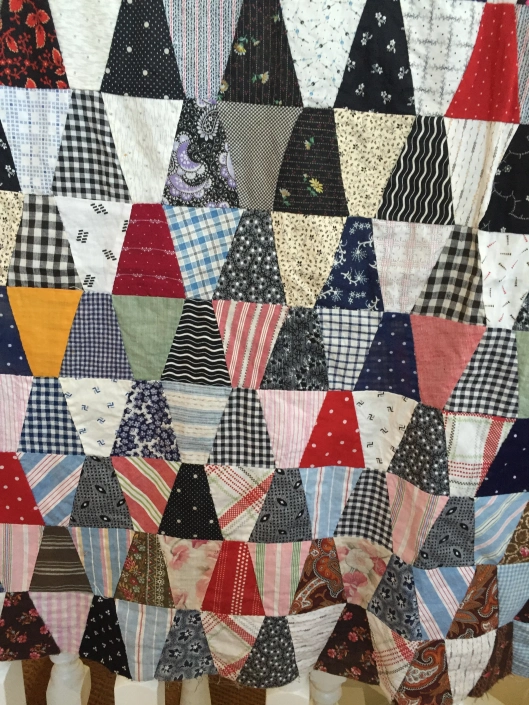
This quilt top contains shirtings, mourning prints, florals, plains, stripes and checks. Two cheddar yellow tumblers and the use of red and white spotted fabrics brighten up the sombre tone of the quilt. The top is hand pieced.

Tumbler Quilt top circa 1900s.
1910’s Triangles

The maker of this quilt planned her use of fabrics carefully making sure she had enough of each one to stitch a row of triangles across the quilt. The fabrics used are typical of the 1910’s but the indigos appear to be from earlier. The indigos are patterned with white and cheddar designs.

Simple shapes make wonderful quilts
I hope you enjoy seeing some of my one patch quilts and may be inspired to use your scraps to carry on this lovely quilting tradition. Happy Patching and thank you for visiting, Janette – The Plain Needlewoman